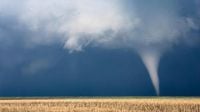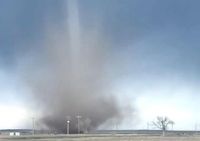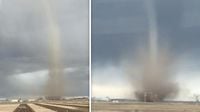In a remarkable weather event, Canada experienced its first tornado of 2025 this past weekend, near Rolling Hills, Alberta. The tornado, classified as a landspout, formed on Saturday, April 12, at approximately 5:20 PM MDT, 10 kilometers northwest of the hamlet. Environment and Climate Change Canada (ECCC) confirmed the tornado's occurrence, noting that it was generated by weak rotation under rapidly growing clouds or weak thunderstorms.
Despite the tornado's formation, which was captured through multiple reports and photographs, it lasted only a brief period and resulted in no reported damage. The tornado was given a preliminary rating of EF-0, indicating it was relatively weak and not particularly threatening to life or property. Meteorologist Kevin Stanfield described landspout tornadoes as generally harmless, stating, "They’re not necessarily all that threatening to people, not that you want to walk into one, but all the same, they can generally cause at most minor damage."
Interestingly, the tornado appeared while the region was still grappling with cold weather conditions, including rain and snow. This unusual juxtaposition of weather phenomena has drawn attention from meteorologists, especially considering the minimal convective available potential energy (CAPE) present at the time, which was just a couple of hundred joules. Typically, such conditions do not favor tornado formation, making this event particularly noteworthy.
Stanfield elaborated on the conditions that led to the tornado's formation, explaining that the setup was perfect for a landspout to develop. "So as that snowstorm was pushing its way along this formation zone, right along this barrier where air is being kicked up into these massive clouds, you’ve got all this moisture, you’ve got these massive clouds, you’ve got enough rotation at the surface, and it helps pull some of that rotation up into the cloud, and before you know, you’ve got a landspout tornado," he said.
Landspout tornadoes differ significantly from their more destructive supercell counterparts. They do not originate from rotating supercells but instead form along points of convergence or an outflow boundary. While they tend to be weaker, with ratings of EF-0 or EF-1, they can still pose dangers, such as toppling trees or damaging roofs. The phenomenon is akin to a small column of rotating air, which, while seemingly harmless, can become more intense under the right atmospheric conditions.
In the wake of the tornado, Alberta remains in a precarious weather situation. The province is more likely to see additional snow rather than another tornado, as meteorologists predict continued cold weather conditions. This tornado was described by Stanfield as a "rare occurrence" for the area, emphasizing that the region is more accustomed to snow during this time of year. He noted, "It’s more likely we see additional snow and less likely we see another tornado. This was pretty out of character for Mother Nature."
The tornado was also notable as it marked the first confirmed tornado in Canada for 2025. Alberta has a history of tornadoes, averaging more than 11 each year. The last tornado recorded in the province was on May 11, 2023, near Cayley, which also received an EF-0 rating. In contrast, the 2024 tornado season started earlier, with Ontario recording its earliest tornado ever on March 16.
With the spring season well underway, meteorologists expect that more severe weather events could unfold in the coming weeks. As the atmosphere continues to warm, conditions may become conducive to further tornado activity, although the specifics will depend on how the weather patterns evolve. The occurrence of this landspout tornado serves as a reminder of the unpredictable nature of spring weather in Canada.
Images and videos of the tornado were shared widely on social media, with many viewers captivated by the unusual sight. Bantry Seed Farms, a third-generation family business owned by Derek Virostek, provided several photographs that documented the tornado as it formed. The visuals captured the dramatic scene, showcasing the swirling clouds and the distinct funnel shape that characterized the landspout.
As communities in Alberta continue to monitor the weather, the recent tornado has sparked discussions about tornado preparedness and the importance of staying informed during severe weather events. While landspout tornadoes are typically less dangerous than their supercell counterparts, they can still catch residents off guard, especially in regions where tornadoes are less common.
Looking ahead, meteorologists will be keeping a close eye on the weather patterns across Canada, particularly in Alberta, where the potential for more tornadoes or severe weather incidents remains. The unexpected formation of this landspout tornado highlights the need for vigilance and preparedness as the spring season progresses.





